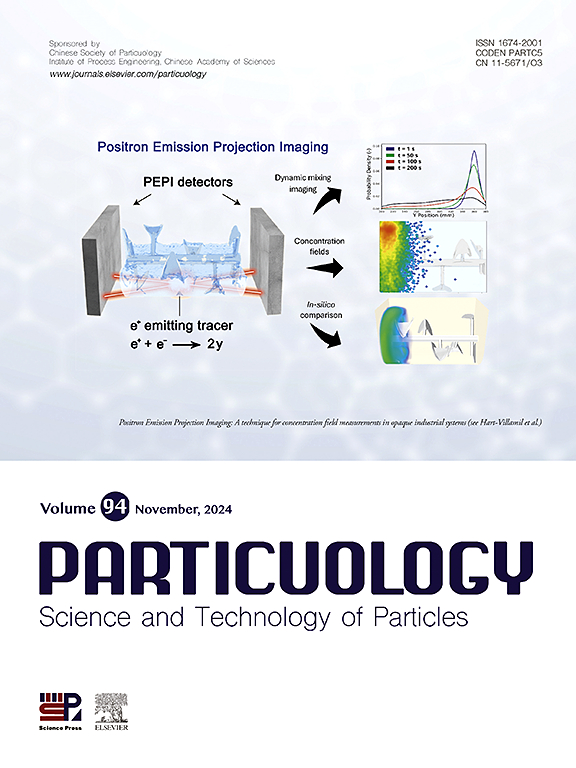基于互联多腔结构的已硝基二苯乙烯/铝微球的制备及其安全性和燃烧性能
IF 4.1
2区 材料科学
Q2 ENGINEERING, CHEMICAL
引用次数: 0
摘要
通过结构调节实现含铝炸药的性能优化,对提高其实际应用价值具有重要意义。本研究采用微喷射液滴技术制备了具有互联多空腔结构的己硝基苯乙烯/铝(HNS/Al)微球,并研究了溶剂配比对微球形貌和多空腔形成的影响。进一步研究了多腔结构对微球分散性、比表面积、热性能、机械灵敏度和燃烧性能的影响。结果表明,与原HNS相比,制备的多腔HNS/Al微球在保持原HNS的晶体结构、化学成分和热稳定性的同时,具有更好的分散性。与固体HNS/Al微球相比,多空腔HNS/Al微球具有更高的比表面积(26.432 vs. 30.987 m2 g−1)和更高的安全性能(3.5 vs. 15 J)。点火试验结果表明,添加铝粉可显著降低HNS的点火延迟(275 vs. 5.0 ms),抑制燃烧过程中碳团簇的形成,从而提高了HNS的燃烧效率。多空腔结构的微球具有较好的燃烧效率。本研究提供了一种制备多结构铝化炸药的方法。本文章由计算机程序翻译,如有差异,请以英文原文为准。

Preparation of hexanitrostilbene/aluminum microspheres with interconnected multi-cavity structure for enhanced safety and combustion performance
Achieving performance optimization of aluminized explosives through structural regulation is of great significance for enhancing their practical application value. In this study, hexanitrostilbene/aluminum (HNS/Al) microspheres with interconnected multi-cavity structures were prepared using microjet droplet technology, and the effect of solvent ratio on microsphere morphology and multi-cavity formation was investigated. Furthermore, the impact of the multi-cavity structure on microsphere dispersibility, specific surface area, thermal properties, mechanical sensitivity, and combustion performance was examined. The results indicate that, compared to raw HNS, the multi-cavity HNS/Al microspheres exhibit improved dispersibility while retaining the crystal structure, chemical composition, and thermal stability of the raw material. In comparison to solid HNS/Al microspheres, the multi-cavity HNS/Al microspheres demonstrate a higher specific surface area (26.432 vs. 30.987 m2 g−1) and improved safety performance (3.5 vs. 15 J). Ignition test results reveal that the addition of aluminum powder significantly reduces the ignition delay of HNS (275 vs. 5.0 ms) and inhibits carbon cluster formation during combustion, thereby enhancing the burning efficiency of HNS. Notably, microspheres with a multi-cavity structure exhibit superior combustion efficiency. This study provides a method for preparing multi-structured aluminized explosives.
求助全文
通过发布文献求助,成功后即可免费获取论文全文。
去求助
来源期刊

Particuology
工程技术-材料科学:综合
CiteScore
6.70
自引率
2.90%
发文量
1730
审稿时长
32 days
期刊介绍:
The word ‘particuology’ was coined to parallel the discipline for the science and technology of particles.
Particuology is an interdisciplinary journal that publishes frontier research articles and critical reviews on the discovery, formulation and engineering of particulate materials, processes and systems. It especially welcomes contributions utilising advanced theoretical, modelling and measurement methods to enable the discovery and creation of new particulate materials, and the manufacturing of functional particulate-based products, such as sensors.
Papers are handled by Thematic Editors who oversee contributions from specific subject fields. These fields are classified into: Particle Synthesis and Modification; Particle Characterization and Measurement; Granular Systems and Bulk Solids Technology; Fluidization and Particle-Fluid Systems; Aerosols; and Applications of Particle Technology.
Key topics concerning the creation and processing of particulates include:
-Modelling and simulation of particle formation, collective behaviour of particles and systems for particle production over a broad spectrum of length scales
-Mining of experimental data for particle synthesis and surface properties to facilitate the creation of new materials and processes
-Particle design and preparation including controlled response and sensing functionalities in formation, delivery systems and biological systems, etc.
-Experimental and computational methods for visualization and analysis of particulate system.
These topics are broadly relevant to the production of materials, pharmaceuticals and food, and to the conversion of energy resources to fuels and protection of the environment.
 求助内容:
求助内容: 应助结果提醒方式:
应助结果提醒方式:


